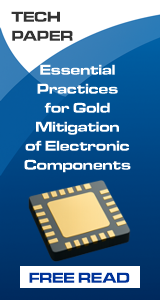| Sponsor |

|
Save Without Compromise
Unlike other low-silver alloys, REL61 delivers 10-20% cost savings while improving performance across key metrics - no trade-offs needed.
AIM Solder
|
|
Influence of Salt Contamination and RH on Creep Corrosion of Immersion Silver
This study provides important insights into the impact of both minor and major contamination on creep corrosion, offering new perspectives on reliability in the field. We hope it will stimulate further research and practical applications in the electronics industry.
Analysis Lab
DOWNLOAD
|
Authored By:
Donghyun Kim, Ph.D., Chen Xu, Ph.D.
Nokia Bell Labs
NJ, USA
Summary
Creep corrosion is the migration of corrosion products due to environmental corrosions of electronics in polluted environment with relative humidity and corrosive gas (NOx, SOx, Cl2 and H2S). Those gases react with copper and silver on the ImAg board, and the formation of corrosion products (CuxS, and AgxS) cause short circuit by creeping and bridging nearby components. Creep corrosion could be promoted by inherited surface features as well as external factors like contamination with salt residue. Although creep corrosion on ImAg has been studied extensively, the effect of commonly found salts on electronic products has been not well understood. In this work, various levels of salt contaminations have been applied on ImAg board, which were exposed to mixed flowing gas (MFG) environment (containing NOx, SO2, Cl2 and H2S) at different relative humidity (RH) to investigate the combined effect of salt and RH on creep corrosion in the harsh environment.
Conclusions
This study demonstrates the following key findings.
- Triton-X (a non-ionic surfactant) does not significantly cause creep corrosion but promotes uniform salt distribution.
- Salt contamination on the ImAg board leads to various degrees of creep corrosion and short circuit formation.
- Chloride salt contamination promotes more creep corrosion than nitrate salt contamination.
- Higher concentration of salt contamination generates more creep corrosion.
- In the present of salt contamination, higher RH environment caused more creep corrosion than lower RH.
- The Critical Relative Humidity (CRH) of salts does not have a direct correlation with creep corrosion.
- Cu(NO3)2 generates more creep corrosion under low RH than high RH.
However, the study is limited by Cu(NO3)2 MFG testing under low RH. Future investigation is needed to explore the clear relation between nitrate salts, especially Cu(NO3)2 and creep corrosion. Overall, this study provides important insights into the impact of both minor and major contamination on creep corrosion, offering new perspectives on reliability in the field. We hope it will stimulate further research and practical applications in the electronics industry.
Initially Published in the SMTA Proceedings
|
Comments
In the 1980s a consortium of companies sponsored research under the direction of William Abbott at Battelle Laboratories to understand the effects of gaseous pollutants on the reliability of electronic components and systems. The outcome of that research is the mixed flowing gas test documented in ASTM B827. The minimum RH in these tests is 68%. Subsequent corrosion studies in China demonstrated that condensation was required to initiate corrosion. It is noteworthy that this study examines the effects of humidity and residual salts extending the knowledge base to include solid contaminants. My one question would be what is meant by the term "low humidity?"
Pat Lees, Littelfuse
|
|
|
|
| Sponsor |

|
BGA Component Rework Simplified
When you're confronted with tough BGA rework, who do you turn to? Discover the #1 resource used by military contractors. We have solutions for all your BGA rework and repair needs.
Circuit Technology Center
|
|
|




